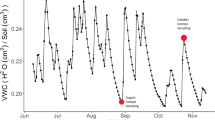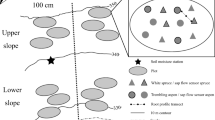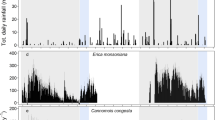Abstract
We measured sap flow in taproots, lateral roots and stems within a single individual in each of three co-occurring tree species in a Chihuahuan desert arroyo to assess the seasonality and magnitude of hydraulic redistribution. Nocturnal reverse flow (hydraulic redistribution) was detected in shallow lateral roots of Fraxinus velutina and Juglans major during periods when surface soils were dry. Reverse flow in the Fraxinus lateral root ranged from near zero to 120 g h-1, and was inversely correlated with nighttime vapor pressure deficit (D), suggesting that nighttime transpiration may have inhibited hydraulic redistribution. Reverse flow in the Juglans lateral root ranged from near zero to 18 g h-1. There was no relationship between reverse flow and nighttime D in the Juglans lateral root, despite a weak positive relationship between nighttime D and rates of basipetal flow (flow towards the stem) in the taproot. Reverse flow in Fraxinus and Juglans ceased when surface soils were wetted by monsoon rains and flooding. We found no reverse flow or seasonal variation in root sap flow in Celtis reticulata. However, basipetal sap flow in Celtis roots continued throughout most of the evening, even during periods when D was near zero, and commenced in the morning more than two hours after the onset of sap flow in the main stem. Patterns of nocturnal root sap flow in Celtis may have been facilitated by the diurnal withdrawal from, and refilling of above ground storage compartments (i.e. above ground diurnal storage capacity), which may have prevented hydraulic redistribution. Species differences in nocturnal root function may have significant impacts on ecosystem hydrological fluxes, and should be considered when scaling fluxes to catchment, landscape, and regional levels.





Similar content being viewed by others
References
Assaf G, Zieslin N (1996) Night water consumption by rose plants. J Hortic Sci 71:673–678
Barrett DJ, Hatton TJ, Ash JE, Ball MC (1995) Evaluation of the heat pulse velocity technique for measurement of sap flow in rainforest and eucalypt forest species of south-eastern Australia. Plant Cell Environ 18:463–469
Becker P, Edwards WRN (1999) Corrected heat capacity of wood for sap flow calculations. Tree Physiol 19:767–768
Burgess SSO, Adams MA, Turner NC, Ong CK (1998) The redistribution of soil water by tree root systems. Oecologia 115:306–311
Burgess SSO, Adams MA, Turner NC, White DA, Ong, CK (2001a) Tree roots: conduits for deep recharge of soil water. Oecologia 126:158–165
Burgess SSO, Adams, MA, Turner NC, Beverly CR, Ong CK, Khan AAH, Bleby TM (2001b) An improved heat pulse method to measure slow and reverse flow in woody plants. Tree Physiol 21:589–598
Burgess SSO, Adams MA, Turner NC, Ong CK, Khan AAH, Beverly CR, Bleby TM (2001c) Correction: an improved heat pulse method to measure low and reverse rates of sap flow in woody plants. Tree Physiol 21:1157
Caldwell MM, Richards JH (1989) Hydraulic lift: water efflux from upper roots improves effectiveness of water uptake by deep roots. Oecologia 79:1-5
Caldwell MM, Dawson TE, Richards JH (1998) Hydraulic lift: consequences of water efflux from the roots of plants. Oecologia 113:151–161
Cohen Y, Fuchs F, Green DC (1981) Improvement of the heat pulse method for determining sap flow in trees. Plant Cell Environ 4:391–397
Dawson TE (1993) Hydraulic lift and water use by plants: implications for water balance, performance and plant-plant interactions. Oecologia 95:565–574
Donovan LA, Grisé, West JB, Pappert RA, Alder NN, Richards JH (1999) Predawn disequilibrium between plants and soil water potentials in two cold-desert shrubs. Oecologia 120:209–217
Edwards WRN, Becker P, Cermak J (1996) A unified nomenclature for sap measurements. Tree Physiol 17:65–67
Emerman SE (1996) Towards a theory of hydraulic lift in trees and shrubs. In: Morel-Seytoux HJ (ed) Sixteenth American Geophysical Union hydrology days. Hydrology Days, Atherton, Calif., pp 147–157
Emerman SE, Dawson TE (1996) Hydraulic lift and its influence on the water content of the rhizosphere: and example from sugar maple, Acer saccharum. Oecologia 108:273–278
Goldstein G, Andrade JL, Meinzer FC, Holbrook NM, Cavelier J, Jackson P, Celis A (1998) Stem water storage and diurnal patterns of water use in tropical forest canopy trees. Plant Cell Environ 21:397–406
Jackson RB, Sperry JS, Dawson TE (2000) Root water uptake and transport: using physiological processes in global predictions. Trends Plant Sci 5:482–488
Marshall DC (1958) Measurement of sap flow in conifers by heat transport. Plant Physiol 33:385–396
Matyssek R, Günthardt-Goerg MS, Maurer S, Keller T (1995) Nighttime exposure to ozone reduces whole-plant production in Betula pendula. Tree Physiol 15:159–165
Meinzer FC, Goldstein G, Andrade JL (2001) Regulation of water flux through tropical forest canopy trees: do universal rules apply? Tree Physiol 21:19–26
Millikin Ishikawa C, Bledsoe CS (2000) Seasonal and diurnal patterns of soil water potential in the rhizosphere in blue oaks: evidence for hydraulic lift. Oecologia 125:459–465
Pate JS, Jeschke WD, Aylward MJ (1995) Hydraulic architecture and xylem structure of the dimorphic root systems of South-West Australian species of Proteaceae. J Exp Bot 46:907–915
Richards JH Caldwell MM (1987) Hydraulic lift: substantial nocturnal water transport between soil layers by Artemisia tridentata roots. Oecologia 73:486–489
Ryel RJ, Caldwell MM, Yoder CK, Or D, Leffler AJ (2002) Hydraulic redistribution in a stand of Artemisia tridentata: evaluation of benefits to transpiration assessed with a simulation model. Oecologia 130:173–184
Schaeffer SM, Williams DG, Goodrich DC (2000) Transpiration of cottonwood/willow forest estimated from sap flux. Agric For Meteorol 105:257–270
Schulze ED, Caldwell MM, Canedell J, Mooney HA, Jackson RB, Parson D, Scholes R, Sala OE, Trimborn P (1998) Downward flux of water through roots (i.e. inverse hydraulic lift) in dry Kalahari sands. Oecologia 115:460–462
Simonneau T, Habib R (1994) Water uptake regulation in peach trees with split-root systems. Plant Cell Environ 17:379-388
Smith DM, Jackson NA, Roberts JM, Ong CK (1999). Reverse flow in tree roots and downward siphoning of water by Grevillea robusta. Funct Ecol 13:256–264
Stratten L, Goldstein G, Meinzer FC (2000) Stem water storage and efficiency of water transport: their functional significance in a Hawaiian dry forest. Plant Cell Environ 23:99–106
Swanson RH (1983) Numerical and experimental analyses of implanted-probe heat pulse velocity theory. Ph.D. Thesis, University of Alberta, Edmonton, Alta
Swanson RH, Whitfield DWA (1981) A numerical analysis of heat pulse velocity and theory. J Exp Bot 32:221–239
Acknowledgements
Thanks to N. English, V. Gempko, S. Greenwood, D. Goodrich, D. Koepke, A. Trafton, and C. Unkrich for their technical assistance. This research was supported by the NSF Science and Technology Center for the Sustainability of semi-Arid Hydrology and Riparian Areas, and by grants from the Cochise County Flood Control District and the Water Resource Research Center at the University of Arizona.
Author information
Authors and Affiliations
Corresponding author
Rights and permissions
About this article
Cite this article
Hultine, K.R., Williams, D.G., Burgess, S.S.O. et al. Contrasting patterns of hydraulic redistribution in three desert phreatophytes. Oecologia 135, 167–175 (2003). https://doi.org/10.1007/s00442-002-1165-4
Received:
Accepted:
Published:
Issue Date:
DOI: https://doi.org/10.1007/s00442-002-1165-4




